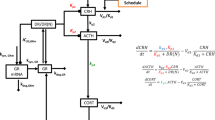Abstract
The hypothalamus–pituitary–adrenal (HPA) system is closely related to stress and the restoration of homeostasis. This system is stimulated in the second half of the night, decreases its activity in the daytime, and reaches the homeostatic level during the late evening. In this paper, we derive and discuss a novel model for the HPA system. It is based on three simple rules that constitute a principle of homeostasis and include only the most substantive physiological elements. In contrast to other models, its main components include, apart from the conventional negative feedback ingredient, a positive feedback loop. To validate the model, we present a parameter estimation procedure that enables one to adapt the model to clinical observations. Using this methodology, we are able to show that the novel model is capable of simulating clinical trials. Furthermore, the stationary state of the system is investigated. We show that, under mild conditions, the system always has a well-defined set-point, which reflects the clinical situation to be modeled. Finally, the computed parameters may be interpreted from a physiological point of view, thereby leading to insights about diseases like depression, obesity, or diabetes.








Similar content being viewed by others
References
Swanson, L.W.: Cerebral hemisphere regulation of motivated behavior. Brain Res. 886(1–2), 113–164 (2000)
Oltmanns, K.M., Fehm, H.L., Peters, A.: Chronic fentanyl application induces adrenocortical insufficiency. J. Intern. Med. 257(5), 478–480 (2005)
Wagner, U., Degirmenci, M., Drosopoulos, S., Perras, B., Born, J.: Effects of cortisol suppression on sleep-associated consolidation of neutral and emotional memory. Biol. Psychiatry 58(11), 885–893 (2005)
McEwen, B.S., Weiss, J.M., Schwartz, L.S.: Selective retention of corticosterone by limbic structures in rat brain. Nature 220(170), 911–912 (1968)
De Kloet, E.R., Vreugdenhil, E., Oitzl, M.S., Joëls, M.: Brain corticosteroid receptor balance in health and disease. Endocr. Rev. 19(3), 269–301 (1998)
Born, J., Fehm, H.L.: Hypothalamus-pituitary-adrenal activity during human sleep: a coordinating role for the limbic hippocampal system. Exp. Clin. Endocrinol. Diabetes 106(3), 153–163 (1998)
Peters, A., Schweiger, U., Pellerin, L., Hubold, C., Oltmanns, K.M., Conrad, M., Schultes, B., Born, J., Fehm, H.L.: The selfish brain: competition for energy resources. Neurosci. Biobehav. Rev. 28(2), 143–180 (2004)
Peters, A., Conrad, M., Hubold, C., Schweiger, U., Fischer, B., Fehm, H.L.: The principle of homeostasis in the hypothalamus–pituitary–adrenal system: new insight from positive feedback. Am. J. Physiol. 293(1), R83–R98 (2007)
Bergman, R.N., Ider, Y.Z., Bowden, C.R., Cobelli, C.: Quantitative estimation of insulin sensitivity. Am. J. Physiol. 236(6), E667–E677 (1979)
Swan, G.W.: Applications of Optimal Control Theory in Biomedicine. Marcel Dekker, New York (1984)
Khoo, M.C.K.: Physiological Control Systems: Analysis, Simulation, and Estimation. IEEE Press Series on Biomedical Engineering. IEEE, New York (1999)
Bingzheng, L., Zhenye, Z., Liansong, C.: A mathematical model of the regulation system of the secretion of glucocorticoids. J. Biol. Phys. 17, 221–233 (1990)
Keenan, D.M., Licinio, J., Veldhuis, J.D.: A feedback-controlled ensemble model of the stress-responsive hypothalamo–pituitary–adrenal axis. Proc. Natl. Acad. Sci. U. S. A 98, 4028–4033 (2001)
Jelić, S., Željko Čupić, Kolar-Anić, L.: Mathematical modeling of the hypothalamic–pituitary–adrenal system activity. Math. Biosci. 197(2), 173–187 (2005)
Gonzalez-Heydrich, J., Steingard, R.J., Putnam, F.W., Bellis, M.D.D., Beardslee, W., Kohane, I.S.: Corticotropin releasing hormone increases apparent potency of adrenocorticotropic hormone stimulation of cortisol secretion. Med. Hypotheses 57(5), 544–548 (2001)
Kyrylov, V., Severyanova, L.A., Vieira, A.: Modeling robust oscillatory behavior of the hypothalamic–pituitary–adrenal axis. IEEE Trans. Biomed. Eng. 52(12), 1977–1983 (2005)
Lenbury, Y., Pornsawad, P.: A delay-differential equation model of the feedback-controlled hypothalamus–pituitary–adrenal axis in humans. Math. Med. Biol. 22(1), 15–33 (2005)
Fehm, H.L., Voigt, K.H., Lang, R.E., Beinert, K.E., Kummer, G.W., Pfeiffer, E.F.: Paradoxical ACTH response to glucocorticoids in Cushing’s disease. N. Engl. J. Med. 297(17), 904–907 (1977)
Murray, J.D.: Mathematical Biology I, 3 edn. Springer, New York (2002)
Ono, N., Bedran de Castro, J.C., McCann, S.M.: Ultrashort-loop positive feedback of corticotropin (ACTH)-releasing factor to enhance ACTH release in stress. Proc. Natl. Acad. Sci. U. S. A. 82(10), 3528–3531 (1985)
Drolet, G., Rivest, S.: Corticotropin-releasing hormone and its receptors; an evaluation at the transcription level in vivo. Peptides 22(5), 761–767 (2001)
Katzper, M.: Adrenal dynamics and corticosteroids. In: Proceedings of the 2003 International Symposium on Health Sciences Simulation, pp. 93–96 (2003)
Savić, D., Jelić, S.: A theoretical study of hypothalamo-pituitary-adrenocortical axis dynamics. Ann. N.Y. Acad. Sci. 1048, 430–432 (2005)
Robinson, C.: Dynamical Systems: Stability, Symbolic Dynamics, and Chaos. CRC, Boca Raton (1999)
Chrousos, G.P.: Ultradian, circadian, and stress-related hypothalamic–pituitary–adrenal axis activity—a dynamic digital-to-analog modulation. Endocrinology 139(2), 437–440 (1998)
Lenbury, Y., Pacheenburawana, P.: Modelling fluctuation phenomena in the plasma cortisol secretion system in normal man. BioSystems 26(2), 117–125 (1991)
Reul, J.M., de Kloet, E.R.: Two receptor systems for corticosterone in rat brain: microdistribution and differential occupation. Endocrinology 117(6), 2505–2511 (1985)
Raol, J.R., Girija, G., Singh, J.: Modelling and Parameter Estimation of Dynamic Systems (IEE Control Engineering). Institution of Engineering and Technology, Herts (2004)
Shampine, L.F., Reichelt, M.W.: The Matlab ODE suite. SIAM J. Sci. Comput. 18, 1–22 (1997)
Conrad, M., Hubold, C., Fischer, B., Schweiger, U., Fehm, H.L., Peters, A.: The “principle of balance”: how do biological systems become homeostatic? (abstract). Exp. Clin. Endocrinol. Diabetes 114, 469 (2006)
Veldhuis, J.D., Iranmanesh, A., Naftolowitz, D., Tatham, N., Cassidy, F., Carroll, B.J.: Corticotropin secretory dynamics in humans under low glucocorticoid feedback. J. Clin. Endocrinol. Metab. 86(11), 5554–5563 (2001)
Calabrese, E.J., Baldwin, L.A.: Toxicology rethinks its central belief. Nature 421(6924), 691–692 (2003)
Acknowledgements
This work was supported by grants (Clinical Research Group KFO-126) from the German Research Foundation.
Author information
Authors and Affiliations
Corresponding author
Rights and permissions
About this article
Cite this article
Conrad, M., Hubold, C., Fischer, B. et al. Modeling the hypothalamus–pituitary–adrenal system: homeostasis by interacting positive and negative feedback. J Biol Phys 35, 149–162 (2009). https://doi.org/10.1007/s10867-009-9134-3
Received:
Accepted:
Published:
Issue Date:
DOI: https://doi.org/10.1007/s10867-009-9134-3




